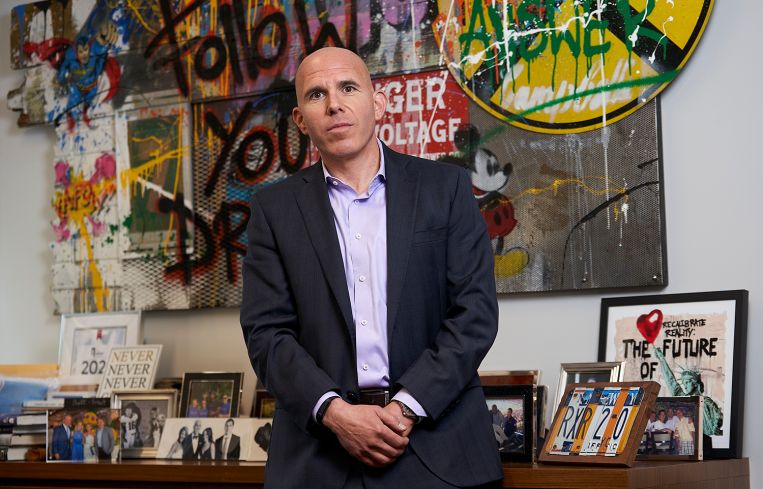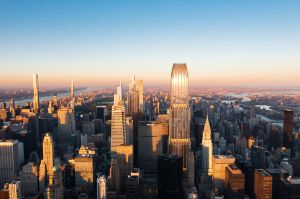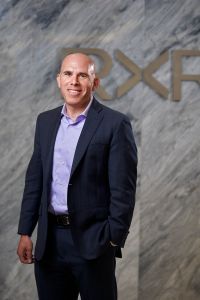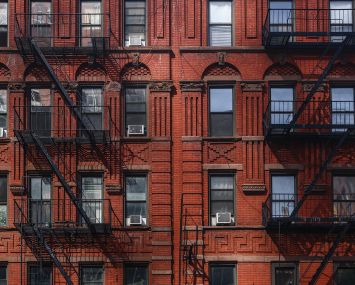Scott to Trot: RXR Expands Outside of New York City in Pandemic Pivot
As RXR expands its footprint to new markets outside of New York City, it's taking its hometown investment strategy on the road
By Cathy Cunningham October 25, 2022 9:00 am
reprints
Think of a real estate firm that embodies the energy of New York City — the consummate New Yorker in company form, if you will— and chances are it’s RXR that comes to mind.
With CEO and Chairman Scott Rechler at the helm, the company has been transacting in the Big Apple since 2007 — longer via predecessor Reckson Associates — and has a portfolio that exudes New York ambition and finesse from every pore. From 75 Rockefeller Plaza to Starrett-Lehigh to 5 Times Square, it’s got you covered. And, with 175 Park Avenue— the Grand Central Terminal supertall that’s set to be the tallest building in the Western Hemisphere — and the JetBlue JFK Terminal project also underway, it doesn’t get more New York than RXR.
Rechler sits in Midtown — at 75 Rock, to be specific— but RXR’s footprint is no longer confined to New York City and the transit-oriented locations around it. An expansion to several new markets, including Phoenix, Denver and Tampa, is part of RXR’s “pandemic pivot” —although the wheels of change were firmly in motion long before we all started singing the “Happy Birthday” song twice while washing our hands.
The firm started observing a generational shift in 2017 in the way people live, work and operate in urban environments. With office valuations inflated and rent growth muted, RXR began to turn its investment focus away from the sector that was once its bread and butter toward asset types that offered more attractive risk-adjusted returns, such as multifamily, self-storage, life sciences and technology.
The move soon showed in the firm’s portfolio. Office transactions once accounted for roughly 58 percent of RXR’s activities, followed by residential deals (36 percent) and other assets comprising the remaining 6 percent of the mix. From 2017 onward, that mix shifted to roughly 64 percent residential, with offices accounting for only 4 percent (and other assets making up the remaining 32 percent of deals).
Further, since the start of 2020 alone, RXR’s multifamily portfolio has grown by 85 percent, with more than 11,400 units now under management and development, and 32 percent of the firm’s multifamily portfolio is now outside of New York City.
Not that RXR is turning its back on its hometown, though. Quite opposite in fact. New York City’s unique heartbeat is one that’s incomparable — something that Rechler doesn’t dispute. But, just as New York evolves in the post-pandemic world, RXR is going through a metamorphosis of its own, expanding its wings toward new ecosystems — specifically, cities that have their own unique heartbeat but also possess similar attributes to RXR’s first love, New York City.
This interview has been edited for length and clarity.
Commercial Observer: Tell us about RXR’s pandemic pivot.
Scott Rechler: COVID was the pivot’s accelerant, but even before the pandemic we were strategically looking at alternative investment strategies. What the pandemic did was make us say, “OK, we need to accelerate this strategy, because if we’re going to serve our investors, partners and communities, we have to take what we’ve accomplished in New York and bring it on the road.”
We’d already been developing a pipeline of activity in other markets, investing in those locations, and starting to develop strategic relationships — not in lieu of continuing to pursue opportunities in New York, but in addition to New York.
We’re being very strategic as to where we’re investing, and pursuing opportunities that are consistent with our themes, which include the megatrends, and what we call the superstar regions — whether those are around New York, or in areas like Phoenix, Tampa, North Carolina, Denver or Dallas. We’re taking our New York strategy to some of these other superstar cities that aren’t necessarily of the same scale of New York, but where we’re seeing talent migration.
Why is the talent aspect important?
When you think about the formula that built New York, it was that this is where the talent wanted to be. That’s still the case, but companies — whether it’s Amazon, Google or any of the others that are out there — are now realizing that they need to also spread themselves to other cities to pick up other pockets of talent. We’re trying to target those mini-microcosms that have a lot of the same attributes that New York City has, and because they’re in the earlier stages of their development they may not have yet hit some of the challenges around capacity and affordability and quality of life that Manhattan did when people began to push out to the outer rings of Manhattan. That’s what we’re looking at in these other markets — those outer rings.
So, we’re asking, where’s the next place people will go, and what do the demand drivers look like there — the education systems, the health care systems, the leadership that invests in infrastructure, the sporting events, the entertainment, the culture, the restaurants.
What was the first market you targeted outside of New York?
Phoenix. I know it pretty well because my wife grew up there, and I’ve watched the city grow. It also had some aspects that checked all our boxes. Arizona State University was putting their grad school there, and they built the light rail network around the city center as well as Diamondback Stadium in walking distance and connected it to that light rail. So we bought some existing buildings that were just finishing construction, as well as some construction sites in the area — probably around 1,200 units.
We then did a similar thing in Tampa, in the Riverwalk area, and in Denver’s RiNo District [River North Art District]. These locations all are connected to their cities by light rail, and they all have a sense of authenticity — we’re not creating it, because it was already naturally created — and are areas that people who are more creative in nature chose to live. They didn’t want to live in the shiny part of the town; they wanted to live in areas with culture and restaurants with a more authentic feel to them.
If you think of New Rochelle and Yonkers here, the theme is the same in that you can pay 30 percent less for an apartment but still have urban living in a quality apartment, with the walkability and the restaurants and the public transit back to the city center that will get you there very quickly.
These are predominantly multifamily investments?
Yes, multifamily and mixed-use. There’s an enormous housing shortage around the country, and in many cases it’s self-inflicted by bad policies of the past that make it so costly to build housing. I think we’ve done a good job of building an identity within our multifamily and for-sale communities, creating a sense of community there, and activating spaces to have a higher level of hospitality for our residents so they’re less transient than they might otherwise be.
Historically, we’ve been worried about transferring what we do in New York City into other markets. Then we realized that Frank Sinatra is right — if you make it here, you can make it anywhere. We approach public-private partnerships in a certain way in New York, and it’s also very transferable, as is our reputation through the major brokerage houses, who all have footprints in those markets. So, when we land in Phoenix or Tampa, people know we’re there to do business, not just kicking tires.
What’s your take on New York City right now? Is the city finally “back”?
For New York to be truly back, you need a critical mass of people. In our office buildings, people are coming back, and more and more companies are now starting to say, “You need to come back,” and building positive momentum.
From a crime perspective, I still think we need more uniformed police officers in high-exposure areas in the subway and in any transit stations. That’s what I would invest in. Even knowing that a surge in visibility is not the norm for us as a city — we need to create an environment where people feel safe. I like the concept, frankly, of putting cameras in the subway. Of course, people would be sensitive knowing there’s a camera there, and it’s really unfortunate we’ve come to this, but I would trade privacy for safety.
Let’s talk about 175 Park Avenue, one of your New York babies. What’s the significance of this development for Midtown East?
The rezoning that was put forward there really illustrates how good policies can result in a harnessing of the private sector, and a positioning of cities — and particularly New York City — to compete in the future. Having policies in place that are centered around taking down old buildings, building new, competitive ones, and investing in the public infrastructure has really played out well. JPMorgan’s new headquarters at 270 Park Avenue is a good example, as is One Vanderbilt, and what we’re doing at 175 Park in tearing down the Hyatt Hotel.
When we deliver it in 2029, 175 Park will be the tallest commercial building in the Western Hemisphere — and it’s something that wouldn’t have happened without that rezoning. It becomes self-fulfilling, because the whole Grand Central marketplace is getting better and better in terms of the quality of the buildings, the quality of the public spaces, and the quality of the infrastructure there — not only from what has been invested because of these projects, but also with the opening of the East Side Access, and eight new tracks under Grand Central. So, when you think about where you want to invest in New York, the ecosystem around Grand Central is long-term a place that you want to be, and where the greatest percentage of our buildings are.
Again, I think COVID accelerated this shift. It’s become something that’s more important than it was before, because of the need to be close to transportation and have walkability. It’s not just buildings that are sustainable and magnetic for people to want to work in, but also communities around them that are activated. That’s why you’re seeing buildings like One Vanderbilt attract the type of rents that they’re attracting, because people want that quality building and they want that location.

Are you in talks with any potential tenants yet?
We are, and we don’t even deliver it until 2029! When you think about companies that want to be in New York or who are already here today and are looking for the home of their future, there’s been a lot of interest from those tenants in 175 — and we’re talking to some interested in taking 1 million-plus square feet. But I can’t say who they are, for now.
What was the hardest part in getting this project off the ground?
We approached it like we approach everything else we do, so we had a tremendous amount of community engagement, and we got the entitlements and the negotiation with the MTA done within a year. We wanted to design a building that was modern and reflected the iconic nature of its location, next to Grand Central and the Chrysler Building.
We worked with our architects [Skidmore Owings and Merrill], and the hardest part about the design was the structural part, because we could only have four landing spots underneath the ground where the train tracks are — so only four spots hold all that weight. So we started with the skeleton, and once that was done, we realized we couldn’t go to another architectural firm to figure out what the design would look like, because the structure is so integrated.
So, we continued to work with the firm and launched a design competition between their offices in Asia, Europe, the Middle East and in different parts of the U.S. We had eight different offices that ran a design competition with us, and ultimately got down to two designs that we liked the most. We ultimately combined those designs to create what it looks like today.
You didn’t make the final two architects duke it out in a boxing ring?
No [laughs], but it was pretty amazing. We’d have video conferencing, and people would be piped in from all around the world and present to us — kind of like one of those “Bake Off” contests. It’s another part of our pandemic pivot — leaning into the buildings that have the most potential in this post-pandemic world. That’s why we’re investing our capital and dedicating our resources toward the 5 Times Squares and the 175 Parks.

Speaking of 5 Times Square, you just closed a $1.3 billion refinance there — no mean feat in this market environment. How does that building fit into the new world you describe?
It goes back to what makes work magnetic. It’s easy to get to — you have 12 subway lines under the building — and it has amenities and open spaces that are attractive. We’re building a restaurant and a whole different series of food alternatives there, a big health club, meeting spaces, bars, experiential retail — a whole slew of activities. Look out your window, and you’re looking at quintessential Times Square to the north and Bryant Park to the south, so you’re really in a location that’s quintessential New York energy. Roku signing the 200,000-square-foot lease speaks to the point that they endorsed that concept.
To your point, it was still challenging to refinance a building like that in this environment, as great as it is. Fortunately, we had existing lenders who were willing to finance us for the next four years.
SL Green converted its previous mezz loan to be an equity partner in the deal, also?
That’s right. Our teams work really well together, across the spectrum. When we sold our old company, Reckson, to them, some of my team members went over to SL Green for a period of time, but I rescued them and brought them back [laughs] so there’s a good connection between us — and this investment gives both of us additional firepower.
The market is a wee bit volatile, to say the very least. What are you seeing, and where are the key opportunities for RXR?
There’s been a big pause. The volatility has caused real anxiety, and people don’t want to make big bets as to what the future holds. You’re already seeing some layoff announcements and hiring freezes, but there’ll be more clarity as people finish their 2023 budgets and ask, “Do we want to be expanding in the face of this uncertainty?” because their cost of capital used to be X, but now it’s twice what X was because borrowing costs have gone up so much.
When it comes to new construction, projects that penciled out when rates were at a lower level don’t pencil out today. This isn’t normal in the sense that it’s probably the steepest rate increase in a 40-year time period, so it’s not like anyone has a plan for this.
There is opportunity to be found within the market dislocation. People need capital to help them through the increased costs related to financing, and there’s not as much financing in the market as there was in the past — so, if you’re someone who can provide that capital, you can fill a void. That’s something we’re doing across the board right now and we’re seeing some very attractive opportunities there.
What you have to try to separate is the parts of the economy that have structural tailwinds — the megatrends — that will ultimately do well despite the negative cycle because, eventually, we’re going to get through this, whether it’s in a year, or 18 months from now.
It must be an interesting time to be on the Federal Reserve Bank of New York’s board of directors.
We all watch the world and see what’s happening, but I think there’s just a different view and better visibility into what’s coming down the pike [there]. At the same time, you can also look through the noise of the moment to see what this might look like on the other side. For me, personally, this is probably my fifth economic shock, but I’ve lived through enough to know the rhythm of them. You see them coming your way, and you know there will be challenges that arise from them.
Tell us more about the capital you mentioned you’re providing today.
As you know, a lot of money center banks have simply said, “We’re not lending” and banks that are lending are only lending to their best borrowers on the best projects, so we’ll come in and do preferred equity on, say, multifamily or logistics opportunities. It’s a debt-like instrument but with equity-like returns.
Would you make a similar investment in an office property?
In the office market there are buildings that will be competitive in this post-pandemic world, so yes. With 5 Times Square, we invested $300 million more equity, but we wouldn’t have done that for every one of our buildings. You pick the ones that if you invest that capital, that building has the bones, the location and the capacity to be a winner in the future. And so we would do that for third parties that have similar properties where we can then help them transition by investing more capital or putting in the amenities to help re-tenant the building.
It feels like only the best borrowers are getting bank financing today. What does that mean for the borrowers further down the food chain with a less stellar track record?
That’s definitely what it feels like. Banks have limited capacity, and they want to be careful how they use that capacity. They’re also a little twofold; they’re not only looking at track record, but also, “Which borrowers are big to my business?” whereas we can say, “OK, these are good borrowers, they’re putting a lot of capital in, and they know how to operate buildings. And, if there are any hiccups, we can help step in and help them.” So, that’s where we do things a little bit differently, and I think it makes us a little bit more uniquely positioned.
We’ve heard a lot about Class B office owners who are in a tough spot, because, even if they can get financing, there’s no guarantee they can turn a property around from a leasing standpoint.
Definitely, and, when we look at our own portfolio, I encourage our team to be intellectually honest and ask, “Which buildings, as we invest money into them, have the ability to be something that’s really competitive in the future?” So you look at 75 Rockefeller Center, 5 Times Square, Pier 57, Starrett Lehigh — where we’re investing a significant amount in restaurants, amenities and open spaces — those are unique buildings that will compete. Same with a lot of our buildings around Grand Central. Even in today’s market, there’s good tenant demand and the market’s telling us, “We like those buildings.” But there are others where that isn’t the case, and, in those circumstances, you have to ask, “OK, is there an alternative use here?” And we’re studying that in a few of our buildings right now.
I always say it’s sort of a Kodak moment, in the sense that those buildings are film but now you’re investing in digital, so you need to extract the best value possible now as a long-term play, because eventually people aren’t going to be using film anymore.
Cathy Cunningham can be reached at ccunningham@commercialobserver.com.



